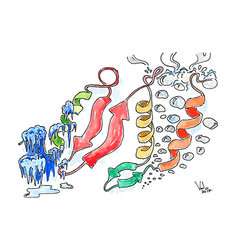A theoretical study explains the 'natural selection' of proteins

Researchers from the Institute of Nanoscience and Nanotechnology of the University of Barcelona (IN2UB) have presented the first computational study that mimics the natural selection of proteins in water under different environmental conditions, aiming to design amino acid sequences able to express their functions at specific temperatures and pressures.
"The results are significant to understand the evolution of proteins on Earth, since they explain why proteins that evolved in early high-temperature environments are able to work at current ambient conditions. We also substantiate the hypothesis that many features observed in proteins arise naturally when the selection process explicitly takes into account the thermodynamic properties of the solvent" explains Giancarlo Franzese, researcher at the IN2UB.
"For example, with our results we can explain why the surface of a folded protein is not 100 percent hydrophilic, something that is energetically unfavorable," adds Valentino Bianco, who holds a doctorate in Physics from the University of Barcelona and is now a postdoctoral fellow at the University of Vienna.
Proteins and their environment
Proteins are large and complex molecules that perform many critical functions in living cells. Proteins have a range of temperatures and pressures for which they are stable. Many life forms thrive under extreme temperatures and pressures, implying that their proteins are naturally selected for their environments. Thanks to this research study, which has been published in the journal Pysical Review X, how selection responds to drastic changes in an aqueous environment is now understood.
The simulations are based on a novel model in which proteins adapt to a range of thermodynamic conditions. "We find that the protein selection process depends strongly on the molecular properties of the surrounding water," explains Giancarlo Franzese. Proteins selected at higher temperatures are also stable over a wider range of temperatures and pressures than those selected at lower temperatures. "We also show that high-temperature proteins show a segregation between hydrophilic surface and hydrophobic core higher than proteins selected at lower temperature," adds Franzese. Therefore, the sequence segregation of a designed protein depends on the selection temperature and pressure, which is consistent with what is observed in natural proteins working at different environmental conditions.
More information: Valentino Bianco et al. Role of Water in the Selection of Stable Proteins at Ambient and Extreme Thermodynamic Conditions, Physical Review X (2017). DOI: 10.1103/PhysRevX.7.021047
Journal information: Physical Review X
Provided by University of Barcelona


















